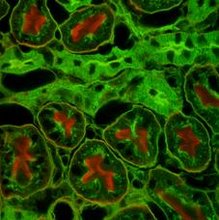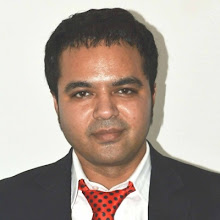Outline:
Remove embryo aseptically from egg and transfer to dish
Materials:
Sterile:
DBSS: dissection BSS (BSS with high conc of antibiotics) in 25-50 ml screw capped tube or universal container
BSS, 50 ml in a sterile beaker (used to cool instruments after flaming)
Small beaker, 20-50 ml or egg cup
Forceps, straight and curved
petridishes
Non-sterile:
embryonated eggs, 10th day of incubation
Alcohol, 70 %
Swabs
Humid incubator (No additional CO2 above atmospheric level)
Protocol:
Incubate eggs at 38.5oC in a humid atmosphere and turn the eggs through h180o daily. Although hen;s egg hatch around 20-21 days, the lengths of their development stages are different from those of mouse embryos. For a culture of dispersed cells from whole embryo, the egg should be taken at about 8 day and for isolated organ rudiment s at about 10-13 days
Swab egg with 70 % alcohol and place it with its blunt end facing up in small beaker
Crack the top of shell and peel the shell off to the edge of air sac with sterile forceps
Re-sterilze the forceps (dip them in alcohol) burn off the alcohol and cool forceps in sterile BSS) and then use forceps to peel off white shell membrane to reveal chorioallantoic membrane (CAM) below with its blood vessels
Pierce CAM with sterile curved forceps, and lift out embryo by grasping it gently under head. Do not close the forceps completely or else neck will sever, place the middle digit under forceps and use finger pad to restrict the pressure of forefinger
Transfer embryo to 9-cm petri dish containing 20ml DBSS (for subsequent dissection and culture)
Part B: Tissue Disaggregation in warm Trypsin :
Outline:
Tissue is chopped and stirred in trypsin for a few hours. The dissociated cells are collected every half hour, centrifuged and pooled in medium containing serum.
Materials:
Sterile/aseptically prepared:
Tissue, 1-5g
DBSS, 50 ml
Trypsin (crude) , 2.5 % in D-PBSA or normal saline
D-PBSA, 200 ml
Growth medium with serum (e.g. DMEM/F12 with 10% FBS)
Culture flasks, 5-10 flasks per g tissue (varies depending on cellularity of tissue)
petri dishes, 9 cm non-tissue culture grade
preweighed vials, 50 ml centrifuge tubes or universal container
Trypsinization flask: 250 ml Erlenmeyer flask or stirrer flask
Magnetic follower, autoclaved in test tube
Curved forceps
Pipettes (Pasteur 2ml/10ml)
Non-sterile:
hemocytometer or cell counter
Magnetic stirrer
Protocol:
Transfer tissue to fresh, sterile DBSS in 9cm petri dish and rinse
Transfer tissue to second dish, dissect of unwanted tissue, such as fat or necrtotic material, and transfer to third dish
Chop with crossed scalpels into about 3mm cubes
Transfer the tissue with curved forceps to preweighed vial or tube
Allow the pieces to settle
Wash the tissue by resuspenidng pieces in DBSS allowing pieces to settle and removing the supernatant fluid. Repeat this step two more times.
Drain vial or tube and reweigh.
Transfer all the pieces to empty trypsinization flask , flushing vial or tube with DBSS.
Remove most of residual fluid and add 180 ml of D-PBSA
Add 20 ml of tryspin (othe renzymes e.g. collagenase , hyaluronidase or Dnase may be added at this stage as well if required)
Add the magnetic follower to the flask
Cap flask and place it on magnetic stirrer in an incubator or hot room at 37oC
Stir about 100 RPM for 30 min at 37oC
After 30 min, collect disaggregated cells as follows,
Allow the pieces to settle
Pout supernant into centrifuge tube and place it on ice
Add fresh tryspin to the pieces remaining in flask and continue to stir and incubate for further 30 min
Centrifuge the harvested cells from step 11b at approx. 500 g for 5 min
Resuspend resulting pellet in 10ml medium with serum and store the suspension o nice
Repeat step 11 until complete disaggregation occurs or until no further disaggregation is apparent
Collect and pool chilled cell suspension, count cells by hemocytometer or electronic cell counter and check viability
As cell population will be very heterogonous , electronic counting require confirmation with hemocytometerbeause calibraion can be difficult
Remove any large aggregates by filtering through sterile muslin or proprietary sieve
Dilute cell suspension to 1 X 106ml in growth medium and seed as many flasks as required, with approx 2 X 105 cells/cm2. When survival rate is unknown or unpredictable a cell count is of little value (e.g. tumor biopsies in which proportion of necrotic cells may be quite high). In this case set up a range of conc. From about 5-25 mg of tissue/ml.
Change the medium at regular intervals (2-4 day as detected by depression of pH) check supernate for viable cells before discarding it as some cells can be slow to attach or may even prefer to proliferate
Subscribe to:
Post Comments (Atom)


No comments:
Post a Comment